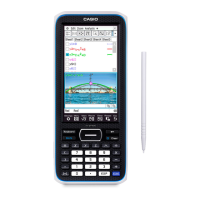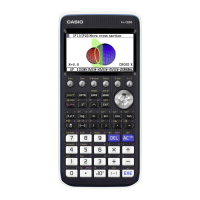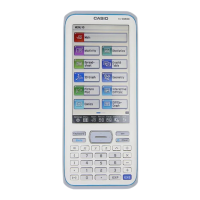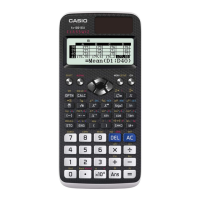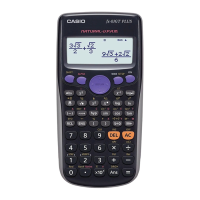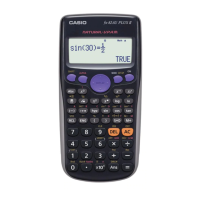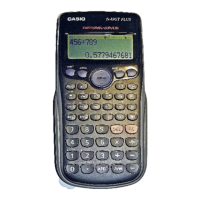Do you have a question about the Casio fx-CP400 and is the answer not in the manual?
Overview of ClassPad hardware and basic functions.
Details battery types, indicators, and replacement for powering the ClassPad.
Covers common operations across all built-in applications, including the application menu.
Details data input methods using the keypad and on-screen soft keyboard.
Explains data types, storage locations, and management using Variable Manager.
Guides on creating new variables and using them in calculations.
Covers settings for number format, angle units, and application configurations.
Provides troubleshooting steps, including RAM reset and initialization.
Explains arithmetic operations, parentheses, and calculation priority.
Details viewing, editing, and deleting past calculations in the work area.
Covers trigonometric, logarithmic, and hyperbolic functions, and angle units.
Explains inputting and performing calculations on list data.
Covers inputting matrix/vector data and performing basic matrix operations.
Explains setting default number bases and performing bitwise operations.
Details transformations, calculus, statistics, and complex number functions.
Explains using the Interactive menu for commands on existing expressions.
Describes drag-and-drop and copy-paste operations between applications.
Explains using the Verify tool to check mathematical manipulations.
Covers probability simulations like dice rolls and ball draws.
Guides on creating, storing, and running programs within the Main application.
Details inputting and storing functions in the Graph Editor for graphing.
Explains configuring view window parameters, panning, and zooming graphs.
Covers generating number tables and summary tables from functions.
Explains moving a pointer on a graph to read coordinates.
Describes adding points, lines, text, and tangent/normal lines to graphs.
Details using G-Solve for graph analysis like finding roots or intersections.
Explains modifying graphs in real-time by changing coefficients or variable values.
Covers selecting preset forms or manually inputting conics equations.
Details drawing parabolas, circles, ellipses, hyperbolas, and general conics.
Explains using G-Solve for analyzing conics graphs, finding features like focus and vertex.
Guides on inputting and graphing first, second, and nth-order differential equations.
Explains overlaying f(x) and parametric function graphs onto differential equation graphs.
Details using trace functionality to read coordinates on differential equation graphs.
Covers using drag-and-drop to graph expressions or values into the DE Graph window.
Explains generating number tables for arithmetic, geometric, and Fibonacci sequences.
Guides on inputting recursion expressions, creating tables, and graphing.
Details creating and maintaining lists (list variables) for statistical calculations.
Covers preparing list data and drawing various statistical graphs like scatter plots and histograms.
Explains calculating mean, median, quartiles, standard deviation, and variance.
Details performing tests, confidence intervals, and distribution calculations using a wizard.
Guides on plotting points, drawing lines, circles, parabolas, and polygons.
Covers selecting, deselecting, moving, copying, and changing colors of figures.
Explains viewing and specifying measurements like coordinates, lengths, and angles.
Details creating and running animations of geometric figures and point loci.
Describes drag-and-drop and copy-paste operations between Geometry and other applications.
Explains how to input equations into the Numeric Solver for finding variable values.
Details how Numeric Solver finds approximate solutions using Newton's method.
Covers basic steps for creating eActivities, inserting text, calculations, and data strips.
Explains file compatibility and transferring eActivity files between units or to a computer.
Covers starting the application and basic page operations like navigating and deleting.
Lists various financial calculation types, their menu items, and examples.
Provides detailed formulas for simple interest, compound interest, cash flow, and amortization.
Lists ClassPad mathematical functions for financial calculations available in the Action menu.
Explains the names of input and output fields used in the Financial application.
Details menus and buttons for Program Loader and Program Editor windows.
Guides on creating, saving, running, and debugging programs on the ClassPad.
Explains how to find and fix programming errors (bugs) in a program.
Covers creating and using custom functions within the ClassPad.
Provides an alphabetical list of program commands, syntax, and meanings.
Shows examples of using graphing, statistical, and financial functions within programs.
Details menus and buttons for navigating and operating the Spreadsheet window.
Explains how to select cells, input data, formulas, and edit cell contents.
Covers basic steps for creating various graph types from spreadsheet data.
Details performing single-variable, paired-variable, and regression calculations.
Explains spreadsheet functions for cell and list calculations.
Covers managing main memory, eActivity area, and storage area, including file operations.
Guides on adjusting display brightness, power properties, language, and keyboard.
Explains configuring communication parameters and connection modes for external devices.
Details connecting to a computer via USB for data transfer and file management.
Covers transferring data between ClassPad units using Communication app or program commands.
Explains how to connect the ClassPad to a CASIO EA-200 Data Analyzer.
Guides on connecting the ClassPad to a projector for screen display.
Lists character codes for various symbols and characters, including 2-byte characters.
Provides tables of error messages and warning messages with their descriptions.
Lists system variables, their descriptions, usage, and type for ClassPad operations.
Shows which graph types and functions are executable within different applications.
| Model | fx-CP400 |
|---|---|
| Category | Calculator |
| Type | Graphing Calculator |
| Display | Color LCD |
| Resolution | 320 x 528 pixels |
| Connectivity | USB |
| Operating System | Proprietary |
| Power | 4 x AAA batteries |
| Weight | 320 g |
